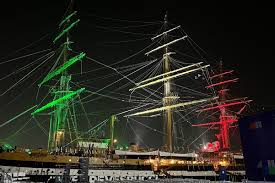 Narrowing India’s $37.85 billion trade deficit with China, a contentious issue between the two Asian giants, will take some out-of-the-box thinking, and greater consumer orientation. Here are some pointers on how it can be done.
Narrowing India’s $37.85 billion trade deficit with China, a contentious issue between the two Asian giants, will take some out-of-the-box thinking, and greater consumer orientation. Here are some pointers on how it can be done.
A few weeks ago, as my wife Sumona was having a manicure at a nail salon in Shanghai, a thirty-something Chinese lady sitting in the next chair excitedly told her that she was simply in love with a handsome Indian star. Naturally, Sumona assumed it would be one of the Khans. “He has big eyes, a lovely smile, and is quite plump. So different from the skinny Chinese men! Look, I carry his picture on my phone,” she said. Pulling out a crystal-encrusted I-Phone 6, she showed the photo of a smiling Ram Kapoor.
Would you have ever imagined that Bade Achche Lagte Hain, a popular TV drama in India, could be so popular in China? Or that one of the most popular dance performances at last year’s Chinese New Year office parties was Jai Ho? Or that thousands of Chinese youth are enraptured by 3 Idiots (San Geshagua in Mandarin) because it reflects exactly the same kind of pressure that they experience?
Yoga Biz
 In the last ten years, Manmohan Singh Bhandari has built a $4 million business. What do he and Yin Yan, his Chinese wife – a former editor in chief with Elle magazine, do? They run the Yogi Yoga Academy, which trains instructors in several cities in China. Once popular among expats, yoga is now extremely popular amongst urban Chinese, for whom the combination of spirituality and exercise is the perfect antidote to a stressful, materialistic life. The academy has branches in Beijing, Shanghai and Guangzhou, a chain of 37 franchisees, has trained more than 6000 instructors, and is recognised by the Chinese Sports Ministry. They publish books on yoga in Chinese and organize trips to Rishikesh.
In the last ten years, Manmohan Singh Bhandari has built a $4 million business. What do he and Yin Yan, his Chinese wife – a former editor in chief with Elle magazine, do? They run the Yogi Yoga Academy, which trains instructors in several cities in China. Once popular among expats, yoga is now extremely popular amongst urban Chinese, for whom the combination of spirituality and exercise is the perfect antidote to a stressful, materialistic life. The academy has branches in Beijing, Shanghai and Guangzhou, a chain of 37 franchisees, has trained more than 6000 instructors, and is recognised by the Chinese Sports Ministry. They publish books on yoga in Chinese and organize trips to Rishikesh.
Say it with flowers
In 2001, a surge in marigold production from China almost wiped out the floriculture business of Kerala-based AV Thomas Group. Rather than fight, the company quickly integrated China into their business operations. Their operations in Heilongjiang province in northeastern China allowed the company to source marigold flowers from Chinese farmers as well as to produce marigold oleoresins in a cost-effective manner. Combining the Indian and Chinese operations allowed AV Thomas to consolidate their position in the world’s flower market.
Sourcing or exporting?
 Much of the discussion over the India-China trade opportunity revolves around industry, power, telecommunications and textiles. These are, and will probably remain the key drivers. A majority of the Indian public and business community views China as a purveyor of cheap goods, and that has resulted in more imports than exports. But after living and working in China for eight years, I believe that the trade gap between the two nations – which stands at a whopping $37.85 billion, with India in deficit, will be bridged only if the opportunity in non-traditional sectors is fully explored. Entertainment, physical fitness / sports and floriculture are just a few examples in the consumer sector where China offers lucrative opportunities.
Much of the discussion over the India-China trade opportunity revolves around industry, power, telecommunications and textiles. These are, and will probably remain the key drivers. A majority of the Indian public and business community views China as a purveyor of cheap goods, and that has resulted in more imports than exports. But after living and working in China for eight years, I believe that the trade gap between the two nations – which stands at a whopping $37.85 billion, with India in deficit, will be bridged only if the opportunity in non-traditional sectors is fully explored. Entertainment, physical fitness / sports and floriculture are just a few examples in the consumer sector where China offers lucrative opportunities.
As the Chinese consumer gets more exposed to the world through travel and the internet, their tastes are getting diverse and they are looking for experiences with a difference. India and Indian entrepreneurs have much to offer.
Chinese weddings
 Take jewellery, for example. Last year, China overtook India as the world’s largest gold market. Traditionally, the Chinese bought gold as an investment, and mostly in the form of coins and bars. It was men who bought gold. But no longer. Women are buying gold jewellery, and it is becoming an important part of the Chinese wedding. However, there is not much choice in design or range in weights available on the market. Indians have that expertise, and it isn’t surprising that some Indian businessmen are doing well here. China has also been attracting Indian diamond traders and manufacturers to its mainland through various tax sops and infrastructural amenities – in 2011, India exported USD 1 billion worth of diamonds to China, and several Indians are on the Shanghai Diamond Exchange.
Take jewellery, for example. Last year, China overtook India as the world’s largest gold market. Traditionally, the Chinese bought gold as an investment, and mostly in the form of coins and bars. It was men who bought gold. But no longer. Women are buying gold jewellery, and it is becoming an important part of the Chinese wedding. However, there is not much choice in design or range in weights available on the market. Indians have that expertise, and it isn’t surprising that some Indian businessmen are doing well here. China has also been attracting Indian diamond traders and manufacturers to its mainland through various tax sops and infrastructural amenities – in 2011, India exported USD 1 billion worth of diamonds to China, and several Indians are on the Shanghai Diamond Exchange.
China’s wedding market itself is worth USD 80 billion, and young affluent couples and their parents spend fortunes on the album shoot – travelling to Paris, New Zealand, Bali, and on themed wedding parties. For some, the European/American style church wedding is so passé. It’s the Great Indian Wedding – made popular through Bollywood, exotic and exuberant, that is drawing their attention. As more cross-cultural weddings take place, such as the recent one in Pune where my former colleague Animesh Narain got married to Ting Zhang, they will serve as a vibrant advertisement for Indian jewellery and textiles. Search on the popular e-commerce site Taobao, and there are scores of vendors offering Indian costumes and jewellery. In the tourist town of Guilin, I spotted an ‘Indian Craft’ store selling kurtis, pashmina shawls, lantern shades from Pipli and Ganesha idols; the Rainbow India Accessory shop in Hangzhou is a popular fashion destination. As of now, the fascination may be limited to four or five photos in the wedding album, but all it will take is a few enterprising wedding planners and fashion designers to capture a significant share of the market.
Exercising caution
 Tales about deals gone sour in China abound in the media and amongst the business community, but like every careful investor would, it is always worth checking the facts and run preliminary checks on the Chinese companies one would like to do business with. At the same time, they would do well to abide by local laws and keep their business commitments. Indians have been arrested by the Chinese authorities for smuggling diamonds and anti-cancer drugs, and illegally detained by their creditors in the small commodities market in Yiwu.
Tales about deals gone sour in China abound in the media and amongst the business community, but like every careful investor would, it is always worth checking the facts and run preliminary checks on the Chinese companies one would like to do business with. At the same time, they would do well to abide by local laws and keep their business commitments. Indians have been arrested by the Chinese authorities for smuggling diamonds and anti-cancer drugs, and illegally detained by their creditors in the small commodities market in Yiwu.
As in most parts of the world, in trade disputes the law usually favours the local. Getting acquainted with the rules and regulations would be an absolute imperative – and there are plenty of firms that can help. The same caution would extend to intellectual property, and Indian businesses should take every possible measure to protect theirs in China. If you’ve created a new jewellery design, how would you prevent it from being copied? If a Chinese TV serial production company says their new drama is ‘inspired’ by a Bollywood movie, can you get them to pay a licensing fee?
Even so, the continued growth of both the Chinese market and consumer power offers Indian businesses myriad opportunities. Narrowing the trade gap is a political and economic commitment on both sides of the Himalaya. It’s up to Indian business to make the most of China’s booming consumer markets.
—————
Vital Stats
109 million Chinese travelled overseas last year, spending over USD 164.8 billion.
649 million Chinese use the internet, 86% of them use the mobile phone to access; they spent USD
1.95 trillion shopping online in 2014. On November 11, 2014, popularly called Singles Day, they spent USD 9.3 billion in 24 hours.
Nearly 400 million Chinese, mostly school and college students are learning English. The English teaching market is worth USD 7.5 billion.
(Kunal Sinha is a consumer foresight and brand strategy expert who has lived in Shanghai for the last 9 years. He is the author of four books, including China’s Creative Imperative, and Raw – Pervasive Creativity in Asia.)
Author Profile
- India Writes Network (www.indiawrites.org) is an emerging think tank and a media-publishing company focused on international affairs & the India Story. Centre for Global India Insights is the research arm of India Writes Network. To subscribe to India and the World, write to editor@indiawrites.org. A venture of TGII Media Private Limited, a leading media, publishing and consultancy company, IWN has carved a niche for balanced and exhaustive reporting and analysis of international affairs. Eminent personalities, politicians, diplomats, authors, strategy gurus and news-makers have contributed to India Writes Network, as also “India and the World,” a magazine focused on global affairs.
Latest entries
 DiplomacyOctober 4, 2025UNGA Resolution 2758 Must Not Be Distorted, One-China Principle Brooks No Challenge
DiplomacyOctober 4, 2025UNGA Resolution 2758 Must Not Be Distorted, One-China Principle Brooks No Challenge India and the WorldJuly 26, 2025MPs, diplomats laud Operation Sindoor, call for national unity to combat Pakistan-sponsored terror
India and the WorldJuly 26, 2025MPs, diplomats laud Operation Sindoor, call for national unity to combat Pakistan-sponsored terror India and the WorldJuly 25, 2025When Fire Ends, Diplomacy Begins
India and the WorldJuly 25, 2025When Fire Ends, Diplomacy Begins India and the WorldJuly 16, 2025Operation Sindoor and its Aftermath: India’s Successful Diplomatic Outreach
India and the WorldJuly 16, 2025Operation Sindoor and its Aftermath: India’s Successful Diplomatic Outreach







